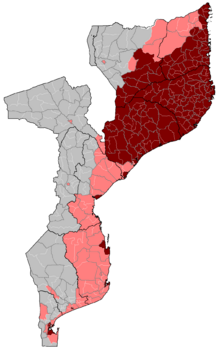Necunian language: Difference between revisions
(Created page with "{{Infobox language | name = Necunian | altname = | nativename = ''al-Lipiṯ an-Neqūnʾalīt'' | acceptance = | image = | image...") |
No edit summary |
||
| (3 intermediate revisions by the same user not shown) | |||
| Line 17: | Line 17: | ||
| extinct = | | extinct = | ||
| era = | | era = | ||
| speakers = | | speakers = 48.2 million native | ||
| date = 2018 | | date = 2018 | ||
| dateprefix = | | dateprefix = | ||
| ref = | | ref = | ||
| refname = | | refname = | ||
| speakers2 = ~ | | speakers2 = ~30 million {{wpl|Second language|L2 speakers}} | ||
| revived = | | revived = | ||
| revived-category = <!-- or revived-cat --> | | revived-category = <!-- or revived-cat --> | ||
| Line 79: | Line 79: | ||
| lingua_ref = | | lingua_ref = | ||
| ietf = | | ietf = | ||
| map = | | map = Necunian language distribution.png | ||
| mapsize = | | mapsize = | ||
| mapalt = | | mapalt = | ||
| mapcaption = | | mapcaption = Necunian language in the [[Necunian League]]<br>{{legend|#7F0000|Majority (>50%) Necunian}}<br>{{legend|#FF7F7F|Sigificant Minority (10-49%) Necunian}} | ||
| map2 = | | map2 = | ||
| mapalt2 = | | mapalt2 = | ||
| Line 104: | Line 104: | ||
Necunian is a mildly inflected {{wpl|Ergative–absolutive language|ergative}} language, with three grammatical cases for animate nouns and pronouns, and two for inanimate nouns, and three numbers (singular, dual, and plural). Adjectives inflect to agree with the class, number, and case of the nouns they modify. The canonical word order is quite strictly VSO. Notably, Necunian has {{wpl|Inflected preposition|inflection of prepositions}} and a relatively large consonant inventory, including a series of four {{wpl|Denti-alveolar consonant|denti-alveolar}} {{wpl|Emphatic consonant|emphatic consonants}}, which are realised as either strong {{wpl|Velarization|velarisation}} or more commonly as {{wpl|Pharyngealization|pharyngealisation}}. | Necunian is a mildly inflected {{wpl|Ergative–absolutive language|ergative}} language, with three grammatical cases for animate nouns and pronouns, and two for inanimate nouns, and three numbers (singular, dual, and plural). Adjectives inflect to agree with the class, number, and case of the nouns they modify. The canonical word order is quite strictly VSO. Notably, Necunian has {{wpl|Inflected preposition|inflection of prepositions}} and a relatively large consonant inventory, including a series of four {{wpl|Denti-alveolar consonant|denti-alveolar}} {{wpl|Emphatic consonant|emphatic consonants}}, which are realised as either strong {{wpl|Velarization|velarisation}} or more commonly as {{wpl|Pharyngealization|pharyngealisation}}. | ||
==History== | |||
==Distribution== | |||
==Dialects== | |||
==Grammar== | |||
Necunian is typologically an {{wpl|Analytic language|analytic-leaning language}} with a moderate degree of inflection on nouns and adjectives. Notably, prepositions are also inflected for person and number. It is an {{wpl|Ergative–absolutive language|ergative–absolutive language}} which {{wpl|Animacy|distinguishes}} between animate and inanimate substantives. | |||
==Phonology== | |||
==Vocabulary== | |||
==Examples== | |||
==See also== | |||
[[category:Languages of the Necunian League]] | [[category:Languages of the Necunian League]] | ||
Latest revision as of 19:09, 23 June 2019
| Necunian | |
|---|---|
| al-Lipiṯ an-Neqūnʾalīt | |
| Pronunciation | /alːipiθ anːɛqu:nʔali:t/ |
| Native to | Necunian League |
| Ethnicity | Necunians |
Native speakers | 48.2 million native (2018) ~30 million L2 speakers |
Early form | Proto-Necunian
|
| Necunian Alphabet | |
| Official status | |
Official language in | Necunian League |
| Language codes | |
| ISO 639-3 | – |
 Necunian language in the Necunian League
Majority (>50%) Necunian Sigificant Minority (10-49%) Necunian | |
Necunian (al-Lipiṯ an-Neqūnʾalīt [alːipiθ anːɛqu:nʔali:t] or simply an-Neqūnʾalīt [anːɛqu:nʔali:t]) is a language isolate that first emerged in the 4th and 5th centuries CE. It is now an official language and lingua franca of the Necunian League. It is named after the Necunians, the primary ethnic group which speak the language natively. The exact total number of speakers, including both native and L2 speakers, is unknown and a matter of some debate. Various estimates have been put forward and vary widely, ranging from 50 million to 100 million.
The Necunian language has, in the 1600 years of its known history, had a visible influence on the other languages of the region — particularly the Maurusian languages of the southern part of the League's territory, providing a significant portion of the languages' respective vocabularies. Maritime, economic, and government terms in particular have often been sourced from Necunian, as the Necunian people were the primary maritime merchants throughout the middle ages.
Necunian is a mildly inflected ergative language, with three grammatical cases for animate nouns and pronouns, and two for inanimate nouns, and three numbers (singular, dual, and plural). Adjectives inflect to agree with the class, number, and case of the nouns they modify. The canonical word order is quite strictly VSO. Notably, Necunian has inflection of prepositions and a relatively large consonant inventory, including a series of four denti-alveolar emphatic consonants, which are realised as either strong velarisation or more commonly as pharyngealisation.
History
Distribution
Dialects
Grammar
Necunian is typologically an analytic-leaning language with a moderate degree of inflection on nouns and adjectives. Notably, prepositions are also inflected for person and number. It is an ergative–absolutive language which distinguishes between animate and inanimate substantives.